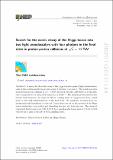Search for the exotic decay of the Higgs boson into two light pseudoscalars with four photons in the final state in proton-proton collisions at √𝑠 = 13 TeV
Author(s)
Tumasyan, A.; Adam, W.; Andrejkovic, J. W.; Bergauer, T.; Chatterjee, S.; Damanakis, K.; Dragicevic, M.; Escalante Del Valle, A.; Frühwirth, R.; Jeitler, M.; Krammer, N.; Lechner, L.; Liko, D.; Mikulec, I.; Paulitsch, P.; Pitters, F. M.; Schieck, J.; Schöfbeck, R.; ... Show more Show less
Download13130_2023_Article_21360.pdf (1.229Mb)
Publisher with Creative Commons License
Publisher with Creative Commons License
Creative Commons Attribution
Terms of use
Metadata
Show full item recordAbstract
Abstract
A search for the exotic decay of the Higgs boson to a pair of light pseudoscalars, each of which subsequently decays into a pair of photons, is presented. The search uses data from proton-proton collisions at
s
$$ \sqrt{s} $$
= 13 TeV recorded with the CMS detector at the LHC that corresponds to an integrated luminosity of 132 fb−1. The analysis probes pseudoscalar bosons with masses in the range 15–62 GeV, coming from the Higgs boson decay, which leads to four well-isolated photons in the final state. No significant deviation from the background-only hypothesis is observed. Upper limits are set on the product of the Higgs boson production cross section and branching fraction into four photons. The observed (expected) limits range from 0.80 (1.00) fb for a pseudoscalar boson mass of 15 GeV to 0.26 (0.24) fb for a mass of 62 GeV at 95% confidence level.
Date issued
2023-07-19Department
Massachusetts Institute of Technology. Department of PhysicsPublisher
Springer Berlin Heidelberg
Citation
Journal of High Energy Physics. 2023 Jul 19;2023(7):148
Version: Final published version